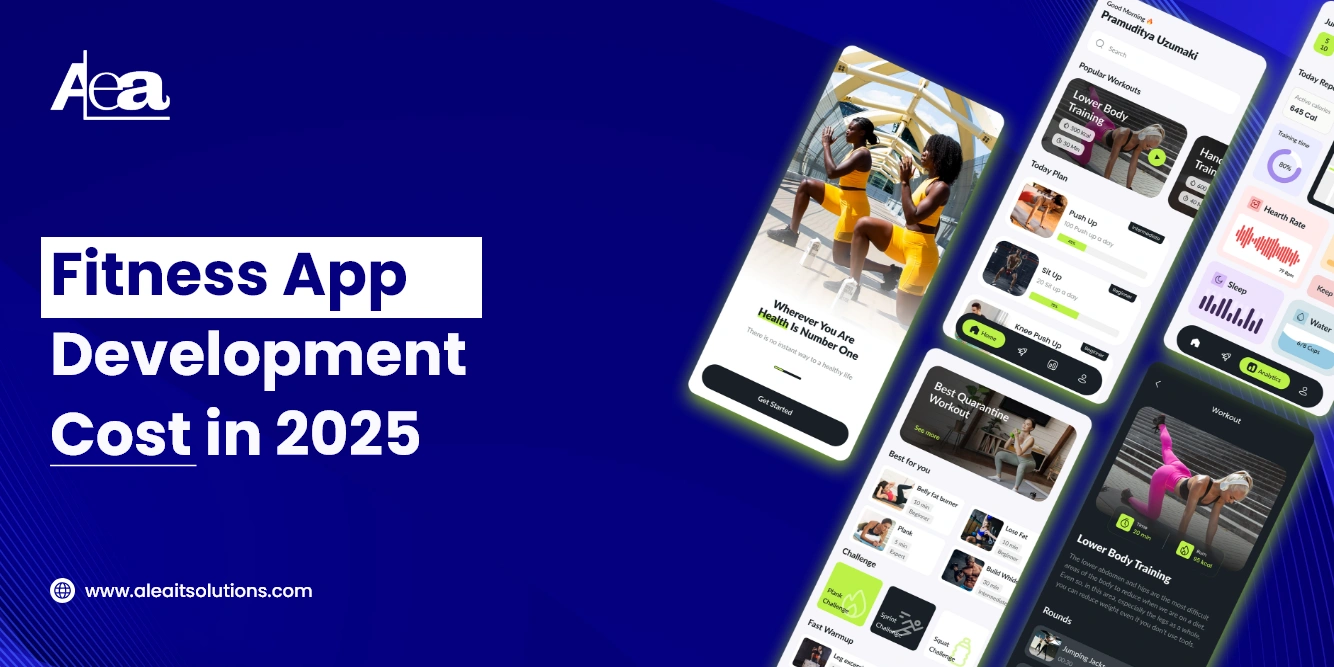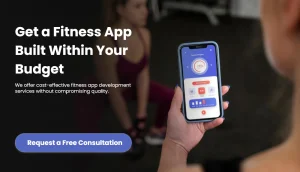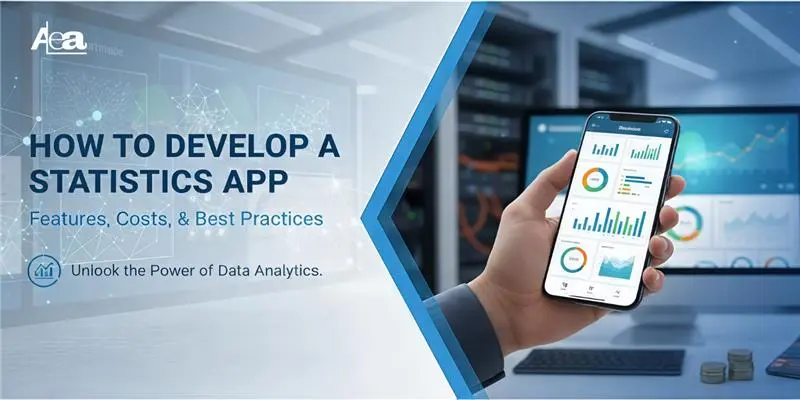A fitness app is a mobile application designed to provide personalized workout plans, wellness tracking, nutrition guidance, and AI-driven coaching helping users achieve their health goals anytime, anywhere.
With the global digital wellness industry projected to exceed $30 billion by 2025, consumer demand for intelligent health platforms is at an all-time high.
According to fantasy app market statistics, the surge in app usage is fueled by growing awareness of preventive healthcare, integration of wearable devices, and the convenience of digital workouts.
By choosing AI fitness app development services, companies can offer advanced features like real-time activity monitoring, virtual trainers, personalized workout recommendations, and progress analytics that significantly enhance user engagement.
Moreover, the rising subscription economy and health-conscious lifestyles make 2025 the ideal time to invest in fitness applications.
With optimized mobile app development cost strategies and innovative monetization models such as freemium subscriptions and in-app purchases, launching a fitness app today is not only technologically feasible but also highly profitable.
Fitness apps are no longer just digital tools they are lifestyle companions driving the future of global health and wellness.
Types of Fitness Apps & Their Core Features
1. Personal Training & Workout Apps
Developing a personal training app with AI coaching, wearables, and live workout features typically costs $40,000 to $90,000 for standard functionality, while advanced apps with real-time coaching, interactive challenges, and personalized algorithms can range from $90,000 to $150,000 or more, depending on feature complexity and technology integration.
2. Activity & Fitness Tracking Apps
Activity tracking apps that monitor steps, heart rate, calories, and sleep through smartphones or wearables typically cost $35,000 to $70,000 for standard features like basic tracking and dashboards.
Advanced apps with real-time analytics, social sharing, personalized insights, and complex sensor data processing can range from $70,000 to $120,000 or more, depending on data accuracy and feature complexity, offering strong user engagement and high market demand.
3. Diet & Nutrition Management Apps
Diet and nutrition apps with basic calorie tracking and meal plans typically cost $30,000 to $60,000, while apps featuring AI-driven diet recommendations, activity tracker integration, and real-time analytics can range from $60,000 to $100,000, depending on the complexity of AI algorithms and database management.
These apps offer strong user retention and monetization potential through subscriptions and in-app purchases.
4. Yoga, Meditation & Mindfulness Apps
Yoga, meditation, and mindfulness apps typically cost $20,000 to $45,000 for basic guided sessions and stress-relief programs.
Apps with video libraries, personalized routines, or subscription models can increase the cost to $45,000–$70,000, but overall, they remain more affordable compared to AI-powered or hybrid fitness apps, making them ideal for early-stage developers targeting the wellness market.
5. Emerging Hybrid & AI-Powered Fitness Solutions
Hybrid fitness apps that combine workouts, activity tracking, nutrition, mindfulness, and advanced AI or AR/VR features typically cost $80,000 to $150,000 for mid-level functionality.
Fully-featured apps with extensive personalization, gamification, and complex backend integration can reach $150,000–$250,000 or more, reflecting their multi-feature complexity.
These apps offer maximum user engagement and strong monetization potential, making them ideal for startups and enterprises targeting the future of digital fitness.
Read Also: Native Apps vs Hybrid Apps: Which One to Choose
Essential Features of a Successful Fitness App
1. User Panel Features
The user panel is the central interface of a fitness app, enabling goal setting, activity logging, nutrition tracking, and progress analytics. For AI-powered apps, it may also include AI-driven workout suggestions and real-time feedback.
Developing a highly intuitive and interactive user panel typically costs $15,000–$50,000, depending on the level of AI integration, analytics complexity, and design sophistication, making it crucial for user engagement and retention.
2. Trainer/Coach Panel Features
Trainer or coach panels let fitness professionals create workout plans, monitor clients, and provide feedback. For AI-powered fitness apps, features like AI recommendations, dashboards, and real-time monitoring are essential.
Developing these panels typically costs $10,000–$35,000, ensuring scalable, personalized, and data-driven coaching for the best AI fitness app 2025.
3. Admin Dashboard Features
The admin dashboard provides centralized control over app operations, including user management, content moderation, analytics, and subscription handling. For AI-powered fitness apps, dashboards often include AI analytics to track engagement and performance.
Developing a secure, scalable admin dashboard typically costs $12,000–$40,000, enabling predictive insights, trend analysis, and real-time reporting for the best AI fitness app 2025.
4. Advanced Features
Advanced features define the uniqueness of modern fitness apps. AI personalization, wearable integration, live-streaming workouts, gamification, and virtual challenges boost engagement. For fitness apps, predictive analytics and AI-driven recommendations are crucial.
Developing these advanced features typically costs $50,000–$200,000+, ensuring AR-based training, real-time coaching, and machine learning insights for the best fitness app 2025.
5. Technology Stack Required
Choosing the right technology stack is crucial for app performance, scalability, and AI integration. Common choices for AI-powered fitness apps include React Native or Flutter, Node.js and Python, and cloud services like AWS or Firebase.
Technology selection during AI fitness app development typically costs $10,000–$30,000, ensuring seamless AI processing, wearable integration, and robust analytics for the fitness app.
Related Insights: FinTech App Development Cost in 2025
Factors Influencing Fitness App Development Cost
Understanding the key factors that influence the fitness app development cost is essential for building scalable, innovative, and future-ready AI-powered fitness apps.
From platform selection to compliance, every element directly impacts the overall budget and timeline of AI fitness app development, especially for creating the best AI fitness app 2025.
1. Platform Choice: iOS, Android, or Cross-Platform
Native apps for iOS and Android require separate codebases, increasing costs, while cross-platform frameworks like Flutter reduce development time.
Costing: Native apps typically cost $40,000–$120,000, and cross-platform apps $35,000–$100,000.
2. App Design & User Experience
A well-designed interface with intuitive navigation, animations, and AI personalization enhances engagement.
Costing: UI/UX design ranges $10,000–$30,000 depending on complexity.
3. Features & Functional Modules
Core features like workout tracking, live classes, AI routines, and predictive analytics significantly affect costs. Costing:
Basic features start at $30,000, while advanced AI modules can reach $100,000+.
4. Backend Infrastructure & Cloud Services
A robust backend supports real-time analytics, AI processing, and authentication.
Costing: Backend and cloud integration typically costs $15,000–$50,000, depending on scalability and storage.
5. Third-Party API & Wearable Integrations
Integrations with Fitbit, Apple Health, Google Fit, or smartwatches enhance personalization but increase complexity. Costing: API and wearable integrations can cost $5,000–$20,000.
6. Development Team Size & Location
Hiring an in-house team, offshore developers, or AI-focused specialists affects costs.
Costing: Skilled AI developers usually charge $50–$150/hour, depending on expertise and location.
7. Compliance & Data Privacy Requirements
Compliance with GDPR, HIPAA, and secure AI data handling is mandatory.
Costing: Compliance features typically cost $5,000–$15,000.
Monetization Strategy
Subscription models, in-app purchases, AI coaching plans, and premium analytics dashboards influence cost. Costing: Implementing monetization features ranges $5,000–$15,000.
Related Insights: E-Wallet App Development Cost in 2025
Estimated Fitness App Development Cost in 2025
The estimated fitness app development cost varies significantly based on app type, features, technology stack, and development region.
Whether you are building a simple activity tracker or an advanced AI-powered fitness solution like Peloton or 8fit, understanding cost breakdowns helps define a realistic development budget and ROI projections.
1. Cost by App Type (Based on Real-World Examples)
| App Type | Example | Development Complexity | Estimated Cost (2025) |
| Basic Activity Tracking App | MyFitnessPal | Medium | $25,000 – $70,000 |
| AI-Based Fitness & Live Workout | Peloton | High | $120,000 – $250,000+ |
| Personalized Wellness & Nutrition | 8fit | High with AI | $80,000 – $180,000 |
| Hybrid AI Wellness App | Custom Solution | Very High (AI, AR/VR) | $200,000 – $350,000+ |
2. Geographical Cost Comparison (Per Hour Development Rate)
| Region | Hourly Rate | Total Cost for Full Project |
| USA & Canada | $80 – $150/hr | $120,000 – $350,000+ |
| Western Europe | $60 – $130/hr | $100,000 – $300,000+ |
| Eastern Europe | $40 – $80/hr | $60,000 – $200,000 |
| India & Asia | $25 – $50/hr | $30,000 – $120,000 |
| Australia | $70 – $140/hr | $110,000 – $300,000+ |
Hiring fitness app developers significantly reduces the cost to develop a fitness app without compromising on quality, especially if you use dedicated application development services with AI expertise.
3. Cost Range for Basic vs. Advanced Features
| Feature Category | Feature Examples | Estimated Cost Range |
| Basic Features | Login, step tracking, meal logs | $20,000 – $50,000 |
| Intermediate Features | Wearable integration, push notifications | $50,000 – $120,000 |
| Advanced AI Features | Personalized coaching, live streaming, AR/VR | $120,000 – $300,000+ |
Key Takeaways
- Basic fitness apps are cost-efficient and suitable for startups or MVP launches.
- AI-powered apps like Peloton and 8fit dominate the market and generate higher ROI but come with increased development investment.
- Outsourcing to a fitness app development company in cost-effective regions like India can reduce total spending by up to 60%.
How Long Does It Take to Develop a Fitness App?
The development timeline for a fitness app largely depends on the complexity of features, integration requirements, use of AI, and whether you are launching a basic MVP or a full-scale product.
On average, a basic fitness tracking app with standard features like user registration, workout logs, and calorie counting can take around 3 to 4 months to develop.
Apps that include moderate features such as wearable integration, custom workout plans, and push notifications generally require 5 to 8 months.
If you aim to develop an AI-powered fitness app with advanced features like virtual personal trainers, predictive analytics, machine learning recommendations, real-time live streaming, and AR/VR-enabled workouts, the timeline expands to 9 to 12 months or more.
Enterprise-level or hybrid apps combining fitness, nutrition, mindfulness, and community engagement with backend analytics and monetization modules may take 12 to 15 months, especially when scalability and global deployment are required.
MVP vs. Full Product Launch Roadmap
Launching an MVP (Minimum Viable Product) is the fastest and most cost-efficient approach, typically taking 8 to 12 weeks.
This version includes only the essential features needed to validate the business idea and attract initial users. It helps reduce the overall fitness app development cost while providing real user feedback that guides future enhancements.
A full product launch, on the other hand, involves designing a feature-rich platform with AI personalization, community engagement tools, subscription models, admin dashboards, and cloud-based infrastructure.
This comprehensive version takes 6 to 12 months, depending on the complexity and the expertise of your fitness app developers or application development servicesprovider.
Fitness App Development Cost Breakdown (By Development Stage)
Understanding how expenses are allocated across each phase helps businesses and startups collaborate effectively with expert Fitness App Developers.
Whether you are planning traditional solutions or next-gen fitness apps, every development stage plays a critical role in determining the final fitness app development cost.
1. Research & MVP Validation
The discovery and planning phase involves market analysis, AI feature validation, and MVP strategy, including user behavior research and revenue model definition.
This phase typically accounts for 10–15% of the total development cost, which usually amounts to $4,000–$22,500 depending on the app’s complexity and overall budget.
2. UI/UX Design
Creating a smooth, intuitive interface with interactive dashboards, AI-driven personalization, and accessibility features is crucial for user retention.
The UI/UX design phase typically accounts for 15–20% of the total development cost, amounting to approximately $6,000–$30,000 depending on the app’s complexity and feature set.
3. Frontend & Backend Development
The core development stage, including user authentication, workout modules, AI coaching engines, and cloud infrastructure, is the most crucial and cost-intensive phase.
For AI-powered fitness apps, integrating real-time analytics and machine learning further increases costs. This phase typically accounts for 35–45% of the total development budget, which can range from $14,000 to $135,000 or more, depending on the app’s complexity and feature set.
4. Integration & Testing
Integration of wearable devices, payment gateways, third-party APIs, and AI performance testing, along with comprehensive QA, ensures seamless app functionality.
This stage typically accounts for 15–20% of the total development cost, amounting to approximately $6,000–$60,000, depending on the app’s complexity and the number of integrations.
5. Deployment & Launch
Deployment includes app store submission, server configuration, and launching AI features on iOS and Android platforms.
This stage typically accounts for 5–10% of the total development cost, which amounts to approximately $2,000–$15,000, depending on app complexity and platform requirements.
6. Maintenance & Updates
Ongoing maintenance, including adding new features, improving AI models, and ensuring compatibility with new devices, is essential for user retention and competitiveness.
This phase typically accounts for 15–25% of the total development cost, amounting to approximately $6,000–$75,000, depending on the app’s complexity and update frequency.
Effective Strategies to Reduce Fitness App Development Cost
Building a high-quality fitness app can be expensive, especially when incorporating advanced features such as AI personalization, wearable integration, or live streaming.
However, implementing smart strategies can help control expenses while ensuring a robust, user-friendly product. Experienced fitness app developers and reliable application development services often recommend approaches that reduce cost without compromising quality.
1. Outsourcing vs. In-House Development
Choosing between an in-house team and outsourcing significantly impacts the fitness app development cost. Hiring full-time developers, designers, and testers locally may provide greater control but is often expensive due to high salaries and operational overhead.
On the other hand, outsourcing to skilled teams or application development services in cost-effective regions allows startups to save up to 60% of the cost to develop a fitness app.
Professional app developers can handle backend, AI integration, and app optimization efficiently while maintaining quality standards.
2. MVP-First Approach
Launching a Minimum Viable Product (MVP) is one of the most effective ways to reduce development expenses. An MVP includes only the core features necessary for initial user adoption and market validation.
This strategy minimizes the fitness app development cost, accelerates time-to-market, and allows developers to gather real user feedback before investing in advanced features.
By starting with an MVP, businesses can prioritize enhancements based on actual user needs, ensuring every additional feature added during full-scale development is valuable.
3. Using Third-Party Integrations
Incorporating ready-made APIs, SDKs, and third-party services for features like payment gateways, wearable device tracking, or AI analytics reduces development time and overall cost of developing a fitness app.
Professional fitness app developers leverage these integrations to avoid building complex systems from scratch. Using third-party services also ensures reliability and scalability while reducing testing overhead, making it a cost-efficient approach.
4. Budget Planning Tips
Careful financial planning is essential for keeping the cost to develop a fitness app under control. Allocate funds for each development stage design, backend, testing, and marketing. Identify non-essential features that can be added post-launch to prevent unnecessary expenses.
Hiring a reputable mobile app development services provider with transparent pricing helps maintain control over unexpected costs.
Proper budget management ensures that even AI-powered and hybrid apps can be developed efficiently without compromising quality.
By outsourcing strategically, starting with an MVP, leveraging third-party integrations, and careful budget planning, businesses can significantly reduce the fitness app development cost while still creating a feature-rich, scalable product
Monetization Models for Fitness Apps
Developing a fitness app is only half the journey monetizing it effectively is equally crucial for long-term sustainability. Here are the most popular monetization strategies used in 2025.
1. Subscription Plans
Subscription-based models are among the most reliable revenue streams for fitness apps. Users pay recurring monthly or yearly fees to access premium content such as AI-guided workouts, live streaming classes, personalized nutrition plans, and advanced analytics.
Implementing subscription tiers requires careful integration by ai app developers, ensuring seamless payment processing and user management. For startups and enterprises, subscription plans provide predictable income while incentivizing users to stay engaged over time.
2. Freemium + Premium Features
The freemium model combines free access to basic features with paid upgrades for advanced functionalities. Basic features might include simple activity tracking or standard workout plans, while premium features unlock AI-driven personalization, virtual coaching, or nutrition guidance.
AI development services can design the app architecture to support smooth feature gating, enabling users to experience the value of the app before converting to paid subscriptions.
3. In-App Purchases
In-app purchases (IAP) offer users the ability to buy additional content or features, such as specialized workout programs, diet plans, or virtual fitness challenges. This model provides flexibility for monetization without forcing users into a subscription.
4. Advertisements & Affiliate Models
Displaying ads or leveraging affiliate marketing is a cost-effective method to generate revenue from free app users. Ads can include health product promotions, wearable devices, or fitness supplements.
Affiliate programs allow the app to earn a commission when users purchase third-party products through the app.
By integrating subscription plans, freemium models, in-app purchases, and advertisements, businesses can diversify revenue streams and ensure sustainable growth.
In 2025, apps that provide seamless AI-driven personalization and flexible monetization options are likely to dominate the fitness app market and achieve higher long-term ROI.
Who Can Benefit from Building a Fitness App?
Creating a fitness app provides value to a wide range of individuals and businesses. Fitness trainers and influencers can extend their reach digitally, offering personalized coaching, AI-guided workouts, and live sessions to their audience.
Gyms and fitness studios can use apps to streamline memberships, schedule classes, track attendance, and provide at-home virtual training, improving member engagement.
Health and wellness brands benefit by integrating apps into their product ecosystem, offering nutrition guidance, supplement tracking, or AI-based lifestyle coaching.
Healthcare professionals can leverage fitness apps to monitor patient activity, support rehabilitation programs, and encourage preventive health practices.
Lastly, tech startups and enterprises can enter the booming digital fitness market by providing AI-powered, hybrid, or niche fitness solutions.
Conclusion: Build Your Fitness App
Investing in a fitness app is a strategic decision that can pay off significantly in the long run, especially when you partner with a reliable fitness app development company. These companies specialize in creating feature-rich, user-friendly apps designed for high performance and seamless user engagement.
As the fitness industry evolves in 2025, leveraging on-demand development services and incorporating AI-driven features will be crucial for staying competitive and meeting the demands of today’s health-conscious consumers.
Effective planning is essential to ensure the app’s development cost is optimized while maximizing potential ROI. Starting with a minimum viable product (MVP), adopting scalable solutions, and utilizing AI features can streamline the development process and reduce overall expenses.
Moreover, working with a fitness app development company that offers on-demand services can help accelerate time-to-market without compromising on quality, allowing your app to shine in a saturated market.
FAQs
How Much Does It Cost to Develop a Fitness App?
The cost varies depending on features, platform choice, and AI integration. Basic apps can cost $25,000–$70,000, while advanced AI-powered apps like Peloton may reach $200,000–$350,000+. Partnering with skilled fitness app developers can optimize costs while ensuring quality.
How Long Does It Take to Build a Fitness App?
A basic MVP can be ready in 8–12 weeks, whereas full-featured AI-powered apps take 6–12 months or more, depending on complexity and integrations.
What Features Are a Must-Have in 2025?
Essential features include AI-based personalized workouts, nutrition planning, wearable integration, live streaming, gamification, and cloud-based analytics.
How Can I Monetize My Fitness App Effectively?
Popular models include subscription plans, freemium features, in-app purchases, and advertisements or affiliate programs. Using multiple streams often ensures higher ROI.
How to Get Started with Fitness App Development?
Start by defining your target audience and core features, validate your idea with an MVP, and partner with experienced fitness app developers or reliable application development services to ensure timely delivery and quality results.







